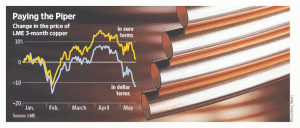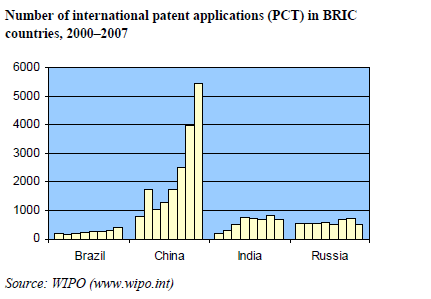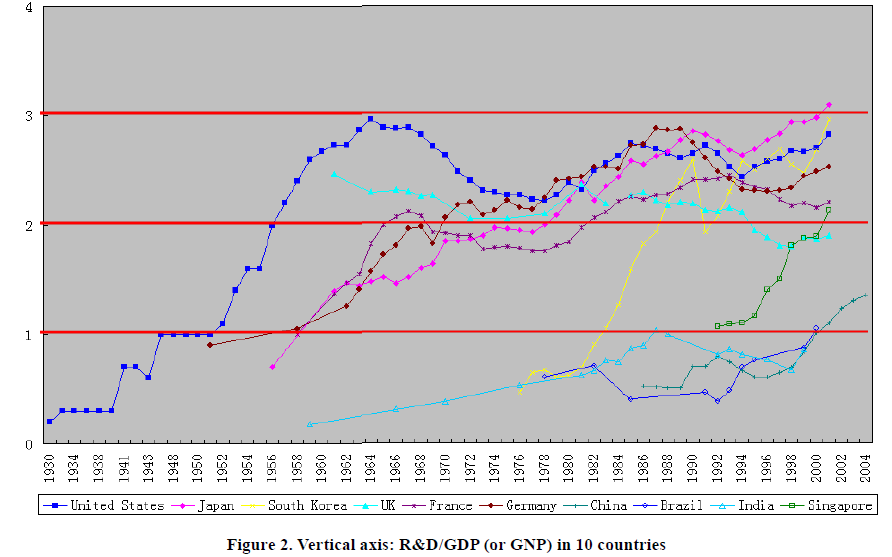Will the market have another 30-40% correction?
David Rosenberg ponders on the question from a historical perspective:
The problem for Mr. Market is that it went into this latest Europe-induced ordeal with an excessively bullish GDP growth outlook for the U.S.A. – at the April highs, we would argue that a GDP growth rate of 6% was effectively being discounted. How nutty is that?
In the aftermath of the correction, the equity market is now pricing in a growth rate closer to 3.5% — the fact that earnings have been rising while the market has been correcting has helped cut the degree of overvaluation in half, to a 0.5 standard deviation from 1.0 just over a month ago on a Shiller normalized P/E ratio basis. But the ECRI leading economic index is actually foreshadowing a deceleration in real GDP growth, to 1.5% in the second half of the year from the 3.75% average pace since the recession technically appeared to have ended around mid-2009. The S&P 500 level that would be consistent with that sort of pace would be closer to 850 than the current level of 1,074. In other words, there is still more air to come out of the balloon.
China to invest $877m in precious metal
China furthers its way into dollar diversification business: this time into precious metal: platinum (source: FT). It will come no surprise to me when China invests in gold miners.
China is set to make its second largest investment in Africa outside the energy sector by ploughing $877m into South Africa’s platinum industry.
The agreement signed last week adds intensity to China’s ambitious drive to sustain its economic boom by securing Africa’s natural resources.
For the first time, Beijing will take a direct stake in the continent’s platinum reserves, the majority of which are in South Africa.
Jinchuan, a Chinese state-owned mining company, is to acquire a 51 per cent stake in Wesizwe, a junior South African platinum developer, for $227m (€185m, £158m).
The China Development Bank will then raise another $650m in project finance to develop its flagship Frischgewaagd-Ledig platinum project, near Rustenburg, west of Pretoria. After the mine is built, Jinchuan will take all of its platinum produced, according to a long-term supply agreement.
“This is a very significant strategic play because it gives China its first direct access to platinum,” said Martyn Davies, chief executive of Frontier Advisory, a Johannesburg company that worked with Wesizwe on the deal.
“The value of the stake is particularly important because of the structure of the world’s platinum market, with the bulk of international output bought and sold as part of long-term contracts, with only about 10 per cent of the metal available on the open market,” Mr Davies said.
The entry of one of China’s largest mining companies into the South African platinum industry follows that of Eurasian Natural Resources Corp, Kazakhstan’s largest miner.
On April 26 ENRC agreed to buy a 12 per cent stake in Northam Platinum for R2.2bn ($280m, €230m, £190m), with many industry analysts expecting ENRC to increase its stake over time.
Like Wesizwe, Northam is on the smaller end of a global platinum industry dominated by three big South African producers: Anglo Platinum, Impala Platinum and Lonmin.
In recent years the main demand for platinum has come from the motor industry, where the metal is used to make catalytic converters, which remove some noxious chemicals from exhaust emissions. But last year demand for platinum jewellery surged, driven by Chinese buyers attracted to lower prices, according to a recent report by Johnson Matthey.
South Africa accounts for some 80 per cent of the world’s platinum group metal production, with Russia accounting for much of the rest. China is the world’s fourth-largest importer, after the European Union, US and Japan, accounting for about 10 per cent of global demand.
The deal’s structure – with a relatively small equity stake supplemented by a more significant project financing component and long-term supply agreements – is becoming a pattern among Chinese resource deals in Africa.
Blog posts during summer travel
I will start some intensive traveling starting from this Thursday: first to Italy, then to China (for a month or so), then to UK. During this period, I will not update my blog as frequent as in the past, but I will still try to send out at least one post (or commentary) each week.
Have a nice summer!
Is this normal correction, or another bear coming?
After yesterday's drop, the US market formally entered correction mode (defined by 10% decline from the recent peak). In finding out what's to come next, I pulled out my tool box.
The findings are quite surprising to me. All indicators seem to point out that there is something big coming. Because most of these indicators are coincidental indicators, so I can't be absolutely sure, but I would say that the risk is clearly on the down side.
First, let's look at S&P 500 volatility index, or VIX – The sharp jump from teen-digit level in April to recent level of 45 really raised my eyebrows. I have been calling several market corrections since March 2009, but every time after a brief correction, the market turned back and resumed climbing up. The current VIX clearly broke such benign pattern – a very strong warning signal.

Now, let's turn to my favorite credit market indicator, the TED spread. Again the same pattern – the long declining trend since Lehman days clearly reversed direction. Because TED spread is calculated using Euro-LIBOR rate, the recent debt crisis in Europe certainly played a role. A rising TED spread signals tightening of credit markets. This won't be good for businesses (especially small businesses), the key to our nascent recovery.

On the international front, let's look at two currency-cross indicators. First is the Aussie-Yen cross, which captures the carry trade using Japanese Yen to invest in commodities-driven economies, such as Australia and Brazil. Rising commodities currencies often signals strong economic growth or recovery ahead. The current big drop of Aussie-Yen cross indicates investors' lost of confidence for a robust of world economic recovery, especially considering China's recent clampdown of her domestic economy (housing market).
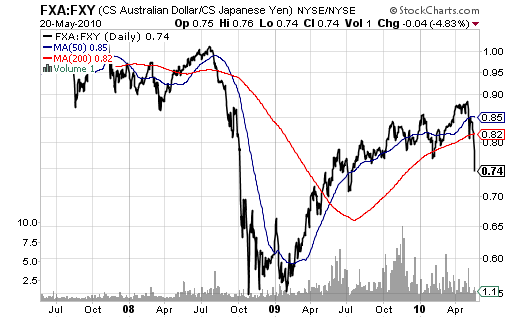
Second is the Euro-Yen cross, which is the most widely used gauge for carry trade sentiment. Again, the sharp decline of this indicator tells a story of panicking (of carry traders). In the past, the indicator is also a flight-to-quality indicator, i.e., investors scale back their risk appetite and seek for safe assets to hide.
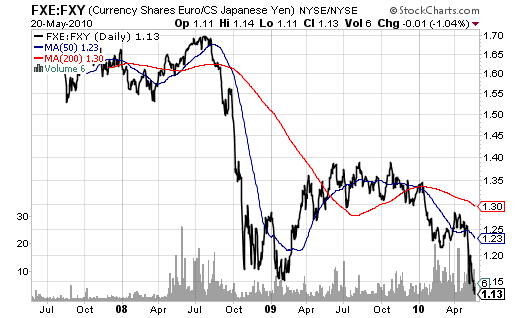
Now, back to the question whether we are going into another bear market.
After a long climb since last March, the market (measured by SP 500 index) has risen an astonishing 82% (before recent correction) from the bottom level at 666. As as May 20, 2010, market P/E was still at 19.44, not cheap at all, compared to the long-term fair value P/E =16.4. (see graph below)
(click on the graph to enlarge)
Further, as shown in the following graph, historically, when the market falls from PE=21 level (the recent high), it at least goes down to PE=17, which means S&P 500 is likely go down to 936, at least.
(click on the graph to enlarge)
But a more careful look at the chart above, you would agree with me that recent crisis mirrors the period during the Great Depression most closely – first a big crash followed by a sharp rebound, then another big drop. The PE ratio in the second big drop during the Great Depression went from around 21 all the way to 12. If this were to happen again (I am not saying this will happen this time around), this would give S&P 500 level at 660, below the previous low (666).
You may argue this scenario is highly unlikely given the Fed's pumping money into the economy like crazy and today we have much better institutional setups compared to 1930s. But don't forget: we have one additional problem – that's the potential debt contagion from Greece and other PIIGS countries in Europe. So it doesn't hurt to take precautions.
In short, the risk is clearly on the down side. It's wise to scale back risky investments and hoard cash again, waiting for opportunities to come.
Comments are welcome.
Euro’s fall drags down commodities
Dollar's rise (Euro's fall) fueled the decline of commodities that are denominated in dollars, reports WSJ.
It is a simple relationship: As Europe's woes fuel the dollar's rise against the euro, dollar-denominated commodity prices fall.
But the malaise runs deeper. The euro zone consumed 10.5 million barrels of oil last year, according to the International Energy Agency. That was down 6% from 2008, but still more than China consumed, and 12% of global demand. Similarly, the euro zone consumes about 15% of the world's copper, much more than the U.S., according to the International Copper Study Group.
A weaker euro will do nothing to revive demand in the region. In dollar terms, oil and copper have fallen this year by 14% and 11%, respectively. In euros, oil is off by only 2%, while copper has risen slightly.
Compounding this is policy. While some might worry that quantitative easing will stoke inflation, the bigger proximate force is deflation, said Charles Dumas at Lombard Street Research, with austerity programs in countries like Greece and perennially tight German consumers. While the euro makes the zone's exports cheaper, its biggest market, the U.K., is weak.
The euro zone's drag extends to that great hope of commodities bulls everywhere: China. China exports as much to Europe as it does to the U.S. The euro's slide against the dollar-pegged yuan makes those imports more expensive at a time when Europeans are tightening their belts anyway. True, commodities are more affordable for China now, but its export markets are weak and Beijing is tightening monetary policy.
Euro-skeptics have long derided the idea of Europe as a major force. Commodities bulls, enduring big falls not just in spot prices but far out along the futures curve, must almost wish they were right.
China took off in science R&D
Given China's size and its high sustained economic growth for the past three decades, China's research (R&D) power has also grown to a level that is beyond its current income level and into the world's top league.
Following my previous post, "Is China rising as a science superpower?" , here is another post on the same issue.
First graph shows China's share of research publications in the fields of natural science (source: R&D Magazine).
While China is long perceived as the "haven for piracy" of intellectual property rights (IPR), China has been increasing its legal protection of IPR and firms (both foreign and domestic) are filing for patents at an astonishing rate.
Both the growth and the absolute number of patent filings in China have been much greater than other emerging economies.
China's total R&D as a percentage of GDP passed 1% level around year 2002, a level widely perceived as a threshold for a country's science and technology to take off.
Here is another graph from Gary Jefferson on the longer historical perspective for science & technology takeoff:
(click graphs to enlarge)
In this financial crisis, China's export sectors got hit very badly. On the optimistic side, this crisis-led creative destruction process will however expedite China's shifting away from the low-end, low-profit-margin business, into more skill-based, value-added sectors. It's reasonable to predict this fast growth in China's R&D will continue in coming years. And within one decade or so, China will rise as a true science superpower.
Mussa on the art of economic forecasting
In my previous post in September 2009, Michael Mussa deviated sharply from blue-chip forecasters and predicted a sharp rebound of US economy. Now in hindsight, although the recovery is short of V-shaped recovery, it has been quite robust.
In this interview, Michael Mussa explains why he predicted so sharply different from others (audio, about 10 mins). His prediction for GDP growth for 2010 is 4% annually, unemployment rate (currently at 9.9%) will come down to 8% by 2011, but will take another 4 years to get to 5% level.




